Two-Dimensional MX2 Semiconductors for Sub-5 nm Junctionless Field Effect Transistors
Abstract
:1. Introduction
2. Calculation Details
3. Subthreshold Swing
4. Other FOMs of the Devices
5. Proposal of the Materials
6. Conclusions
Acknowledgments
Author Contributions
Conflicts of Interest
References
- Franklin, A.D. Nanomaterials in transistors: From high-performance to thin-film applications. Science 2015, 349. [Google Scholar] [CrossRef] [PubMed]
- Cao, W.; Kang, J.; Sarkar, D.; Liu, W.; Banerjee, K. 2D semiconductor FETs-projections and design for sub-10 nm VLSI. IEEE Trans. Electron Dev. 2015, 62, 3459–3469. [Google Scholar] [CrossRef]
- Agarwal, T.; Yakimets, D.; Raghavan, P.; Radu, I.; Thean, A.; Heyns, M.; Dehaene, W. Benchmarking of MoS2 FETs with multigate Si-FET options for 5 nm and beyond. IEEE Trans. Electron Dev. 2015, 62, 4051–4056. [Google Scholar] [CrossRef]
- Mishra, V.; Smith, S.; Liu, L.; Zahid, F.; Zhu, Y.; Guo, H.; Salahuddin, S. Screening in ultrashort (5 nm) channel MoS2 transistors: A full-band quantum transport study. IEEE Trans. Electron Dev. 2015, 62, 2457–2463. [Google Scholar] [CrossRef]
- Chau, R.S.; Doyle, B.S.; Datta, S.; Kavalieros, J.; Zhang, K. Integrated nanoelectronics for the future. Nat. Mater. 2007, 6, 810–812. [Google Scholar] [CrossRef] [PubMed]
- Mamaluy, D.; Gao, X. The fundamental downscaling limit of field effect transistors. Appl. Phys. Lett. 2015, 106, 193503. [Google Scholar] [CrossRef]
- Ghosh, R.K.; Mahapatra, S. Monolayer transition metal dichalcogenide channel-based tunnel transistor. IEEE J. Electron Dev. Soc. 2013, 1, 175–180. [Google Scholar] [CrossRef]
- Zhang, Q.; Iannaccone, G.; Fiori, G. Two-dimensional tunnel transistors based on bi2se3 thin film. IEEE Electron Dev. Lett. 2014, 35, 129–131. [Google Scholar] [CrossRef]
- Dong, Z.; Guo, J. Assessment of 2-d transition metal dichalcogenide FETs at sub-5-nm gate length scale. IEEE Trans. Electron Devices 2017, 64, 622–628. [Google Scholar] [CrossRef]
- Liu, Y.; Guo, J.; Wu, Y.; Zhu, E.; Weiss, N.O.; He, Q.; Wu, H.; Cheng, H.; Xu, Y.; Shakir, I.; et al. Pushing the performance limit of sub-100 nm molybdenum disulfide transistors. Nano Lett. 2016, 16, 6337–6342. [Google Scholar] [CrossRef] [PubMed]
- Desai, B.; Madhvapathy, S.R.; Sachid, A.B.; Llinas, J.P.; Wang, Q.; Ahn, G.H.; Pitner, G.; Kim, M.J.; Bokor, J.; Hu, C.; et al. MoS2 transistors with 1-nanometer gate lengths. Science 2016, 354, 99–102. [Google Scholar] [CrossRef] [PubMed]
- Lilienfeld, J.E. Method and Apparatus for Controlling Electric Current. U.S. Patent 1,745,175, 22 October 1925. [Google Scholar]
- Lee, C.W.; Afzalian, A.; Akhavan, N.D.; Yan, R.; Ferain, I.; Colinge, J.P. Junctionless multigate field-effect transistor. Appl. Phys. Lett. 2009, 94, 053511. [Google Scholar] [CrossRef]
- Lee, C.; Nazarov, A.N.; Ferain, I.; Akhavan, N.D.; Yan, R.; Razavi, P.; Yu, R.; Doria, R.T.; Colinge, J. Low subthreshold slope in junctionless multigate transistors. Appl. Phys. Lett. 2010, 96, 102106. [Google Scholar] [CrossRef]
- Agarwal, T.; Soree, B.; Radu, I.; Raghavan, P.; Fiori, G.; Iannaccone, G.; Thean, A.; Heyns, M.; Dehaene, W. Comparison of short-channel effects in monolayer MoS2 based junctionless and inversion-mode field-effect transistors. Appl. Phys. Lett. 2016, 108, 023506. [Google Scholar] [CrossRef]
- Agarwal, T.; Radu, I.; Raghavan, P.; Fiori, G.; Thean, A.; Heyns, M.; Dehaene, W. Effect of material parameters on two-dimensional materials based TFETs: An energy-delay perspective. In Proceedings of the 2016 46th European Solid-State Device Research Conference (ESSDERC), Lausanne, Switzerland, 12–15 September 2016; pp. 55–58. [Google Scholar]
- Liu, L.; Lu, Y.; Guo, J. On monolayer MoS2 field-effect transistors at the scaling limit. IEEE Trans. Electron Dev. 2013, 60, 4133–4139. [Google Scholar] [CrossRef]
- Fang, H.; Chuang, S.; Chang, T.C.; Takei, K.; Takahashi, T.; Javey, A. High performance single layered WSe2 p-FETs with chemically doped contacts. Nano Lett. 2012, 12, 3788–3792. [Google Scholar] [CrossRef] [PubMed]
- Bruzzone, S.; Iannaccone, G.; Marzari, N.; Fiori, G. An open-source multiscale framework for the simulation of nanoscale devices. IEEE Trans. Electron Dev. 2014, 61, 48–53. [Google Scholar] [CrossRef]
- Zhang, L.; Chan, M. Tunneling Field Effect Transistor Technology; Springer International Publishing: Dordrecht, Switzerland, 2016. [Google Scholar]
- Alam, K.; Lake, R.K. Monolayer MoS2 transistors beyond the technology road map. IEEE Trans. Electron Dev. 2012, 59, 3250–3254. [Google Scholar] [CrossRef]
- Yoon, Y.; Ganapathi, K.; Salahuddin, S. How good can monolayer MoS2 transistors be. Nano Lett. 2011, 1, 3768–3773. [Google Scholar] [CrossRef] [PubMed]
- Fiori, G.; Iannaccone, O.G. Nanotcad Vides. 2013. Available online: http://vides.nanotcad.com (accessed on 17 April 2016).
- Lake, R.; Klimeck, G.; Bowen, R.C.; Jovanovic, D. Single and multiband modeling of quantum electron transport through layered semiconductor devices. J. Appl. Phys. 1997, 81, 7845–7869. [Google Scholar] [CrossRef]
- Chang, J. Modeling of anisotropic two-dimensional materials monolayer HfS2 and phosphorene metal-oxide semiconductor field effect transistors. J. Appl. Phys. 2015, 117, 214502. [Google Scholar] [CrossRef]
- Giannozzi, P.; Baroni, S.; Bonini, N.; Calandra, M.; Car, R.; Cavazzoni, C.; Ceresoli, D.; Chiarotti, G.L.; Cococcioni, M.; Dabo, I.; et al. Quantum ESPRESSO: A modular and open-source software project for quantum simulations of materials. J. Phys. Cond. Matter. 2009, 21, 395502. [Google Scholar] [CrossRef] [PubMed]
- Perdew, J.P.; Wang, Y. Accurate and simple analytic representation of the electron-gas correlation energy. Phys. Rev. B 1992, 45, 13244–13249. [Google Scholar] [CrossRef]
- Sholl, D.; Steckel, J.A. Density Functional Theory: A Practical Introduction; Wiley: Indianapolis, IN, USA, 2009. [Google Scholar]
- Wang, H.; Chang, S.; He, J.; Huang, Q.; Liu, F. The dual effects of gate dielectric constant in tunnel FETs. IEEE J. Electron Dev. Soc. 2016, 4, 445–450. [Google Scholar] [CrossRef]
- Huang, Z.; Zhang, W.; Zhang, W. Computational search for two-dimensional MX2 semiconductors with possible high electron mobility at room temperature. Materials 2016, 9, 716. [Google Scholar] [CrossRef] [PubMed]
- Sarkar, D.; Xie, X.; Liu, W.; Cao, W.; Kang, J.; Gong, Y.; Kraemer, S.; Ajayan, P.M.; Banerjee, K. A subthermionic tunnel field-effect transistor with an atomically thin channel. Nature 2015, 526, 91–95. [Google Scholar] [CrossRef] [PubMed]
- Bhattacharjee, S.; Ganapathi, K.L.; Mohan, S.; Bhat, N. A sub-thermionic MoS2 FET with tunable transport. Appl. Phys. Lett. 2017, 111, 163501. [Google Scholar] [CrossRef]
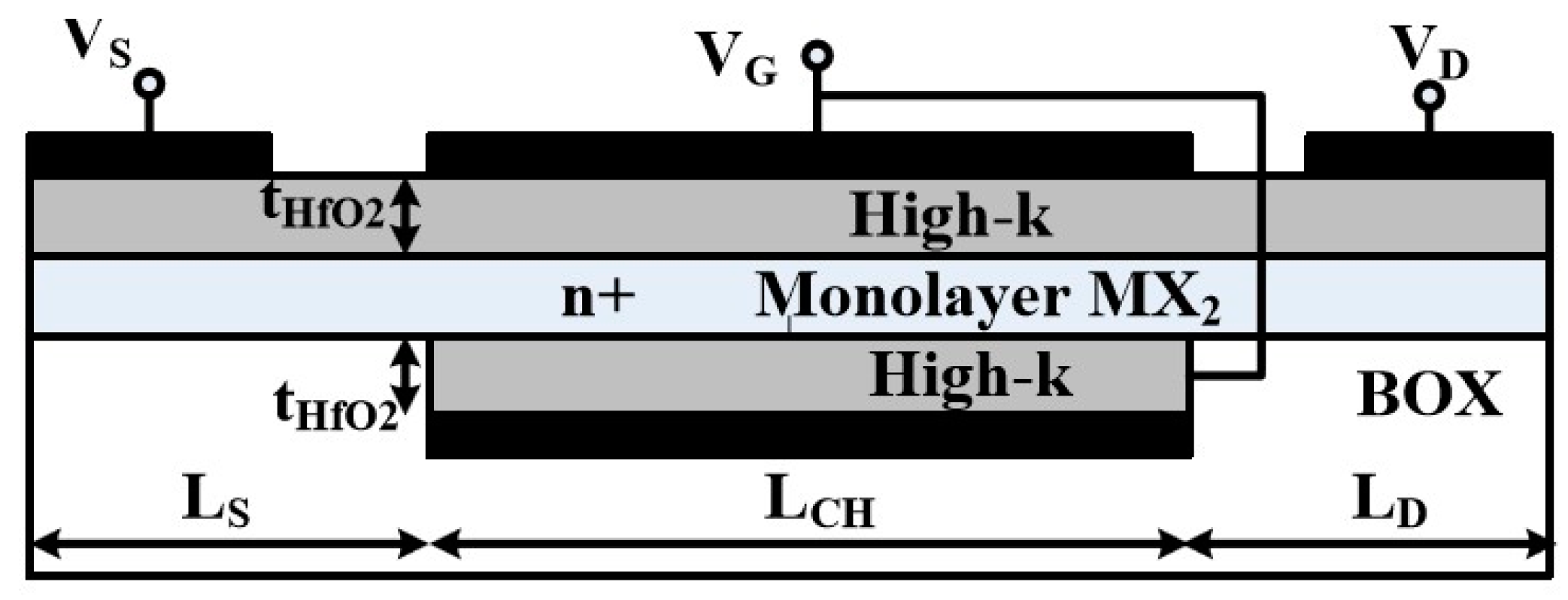
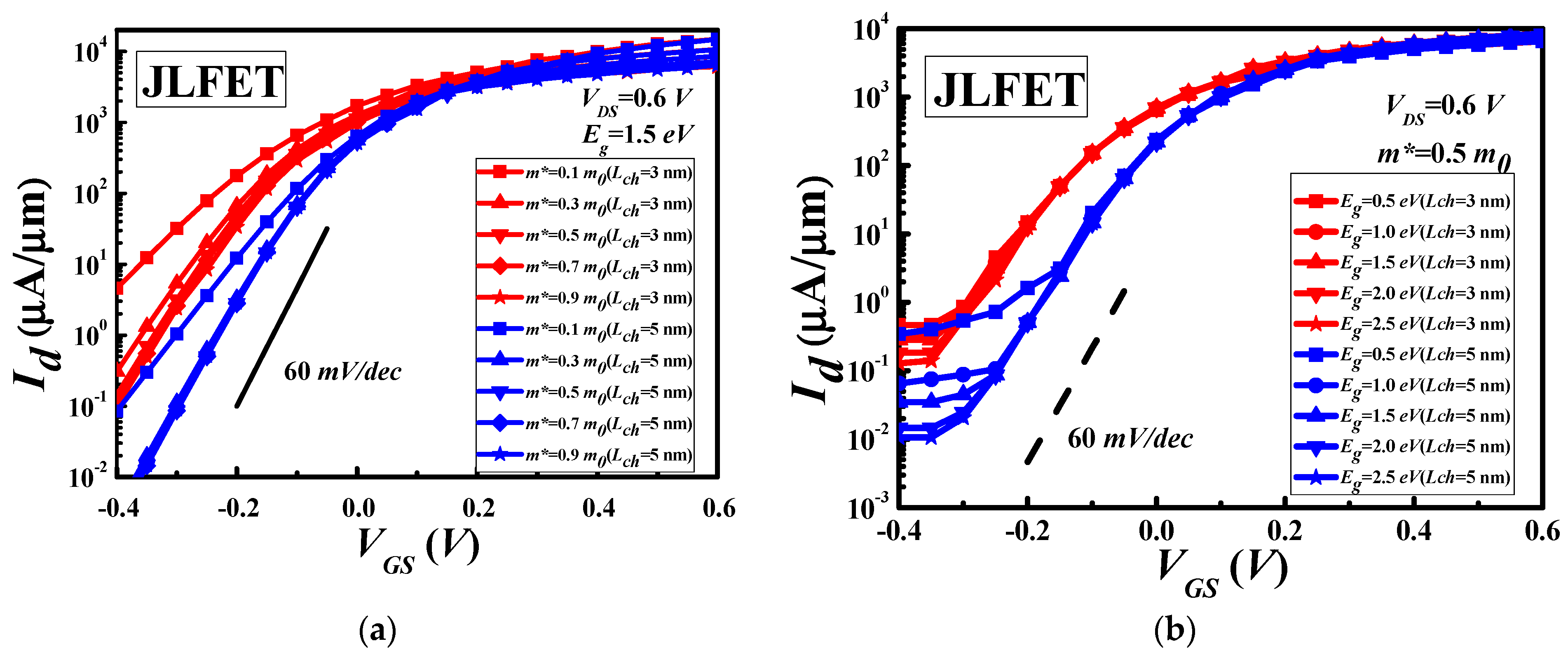
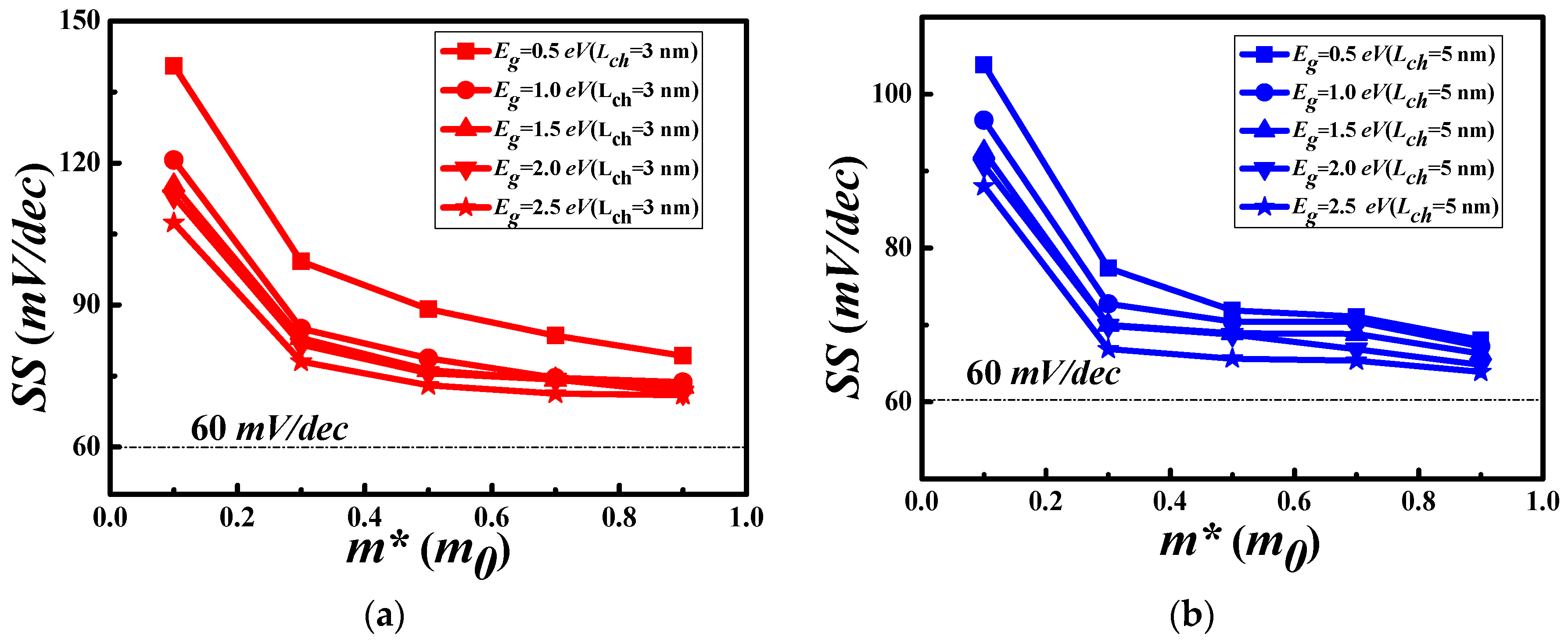

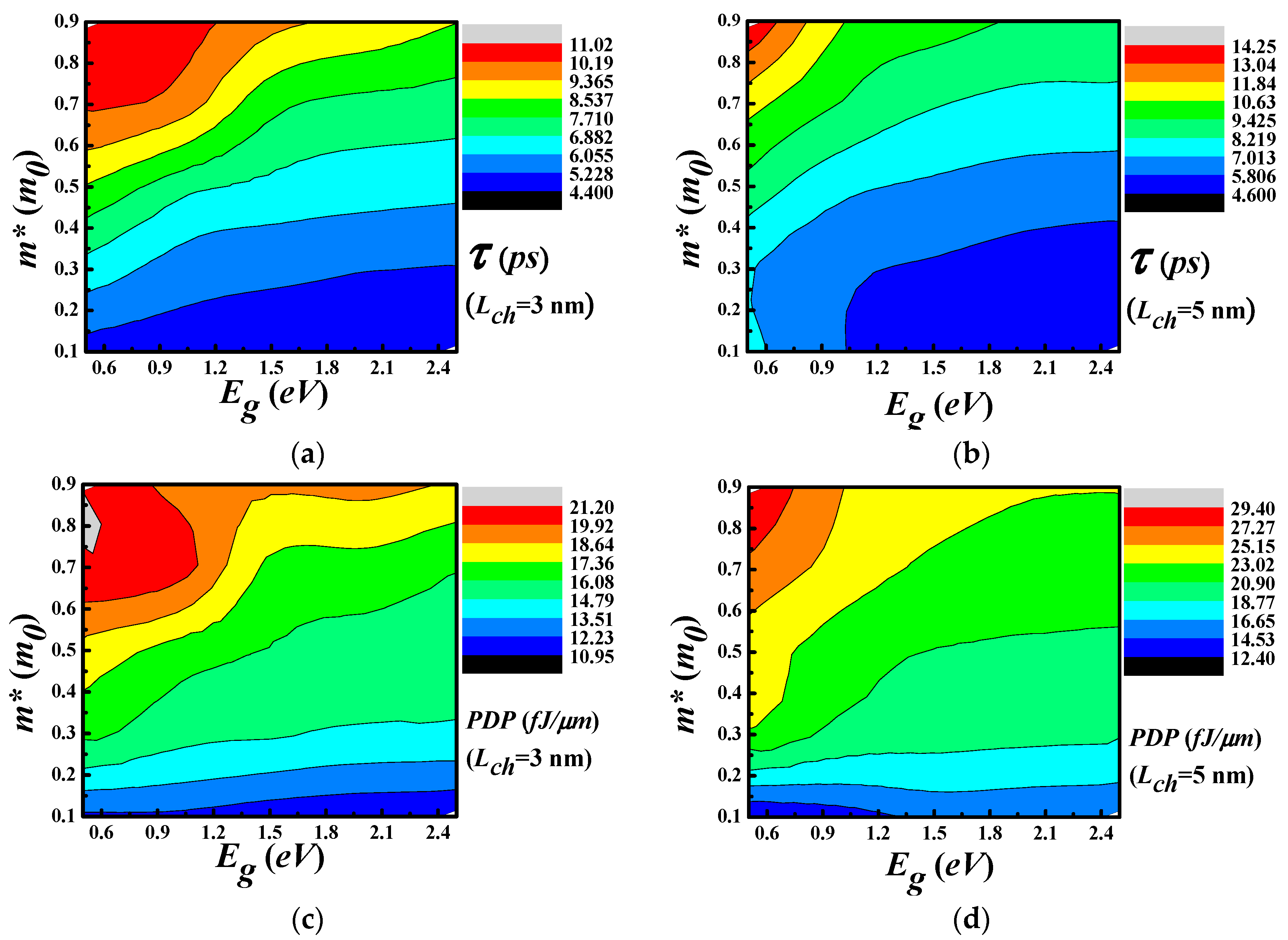
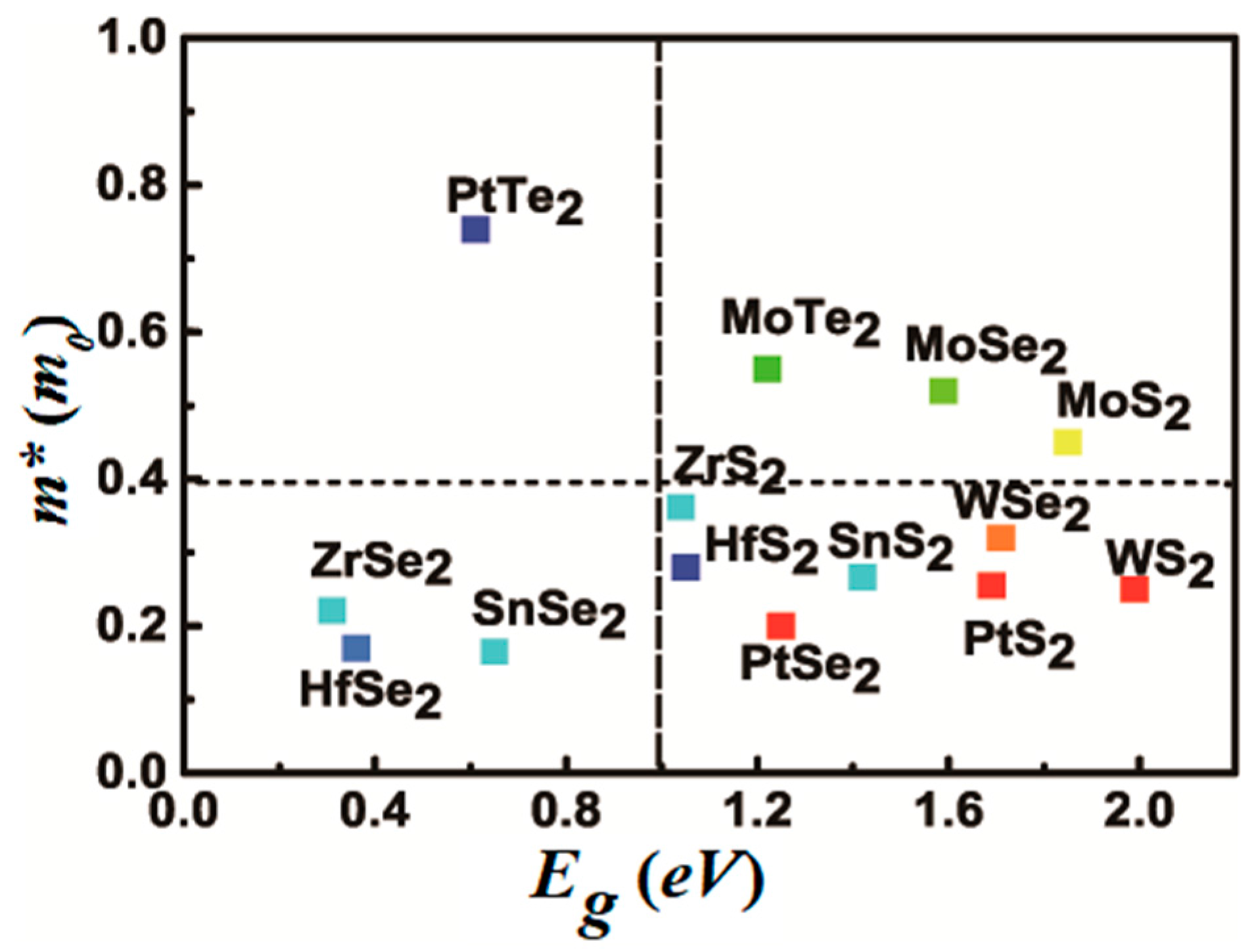
© 2018 by the authors. Licensee MDPI, Basel, Switzerland. This article is an open access article distributed under the terms and conditions of the Creative Commons Attribution (CC BY) license (http://creativecommons.org/licenses/by/4.0/).
Share and Cite
Peng, B.; Zheng, W.; Qin, J.; Zhang, W. Two-Dimensional MX2 Semiconductors for Sub-5 nm Junctionless Field Effect Transistors. Materials 2018, 11, 430. https://doi.org/10.3390/ma11030430
Peng B, Zheng W, Qin J, Zhang W. Two-Dimensional MX2 Semiconductors for Sub-5 nm Junctionless Field Effect Transistors. Materials. 2018; 11(3):430. https://doi.org/10.3390/ma11030430
Chicago/Turabian StylePeng, Bin, Wei Zheng, Jiantao Qin, and Wanli Zhang. 2018. "Two-Dimensional MX2 Semiconductors for Sub-5 nm Junctionless Field Effect Transistors" Materials 11, no. 3: 430. https://doi.org/10.3390/ma11030430
APA StylePeng, B., Zheng, W., Qin, J., & Zhang, W. (2018). Two-Dimensional MX2 Semiconductors for Sub-5 nm Junctionless Field Effect Transistors. Materials, 11(3), 430. https://doi.org/10.3390/ma11030430



